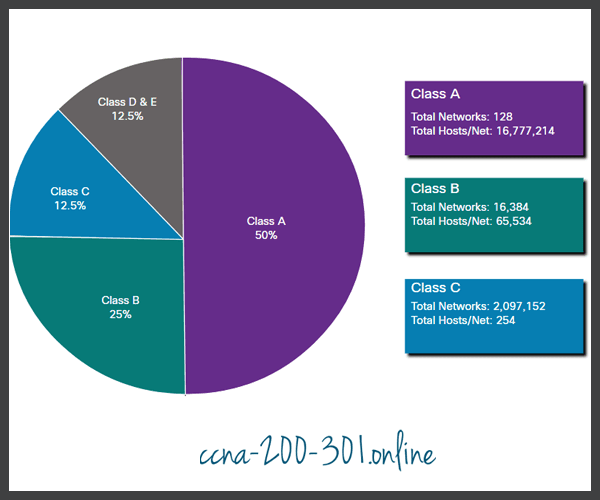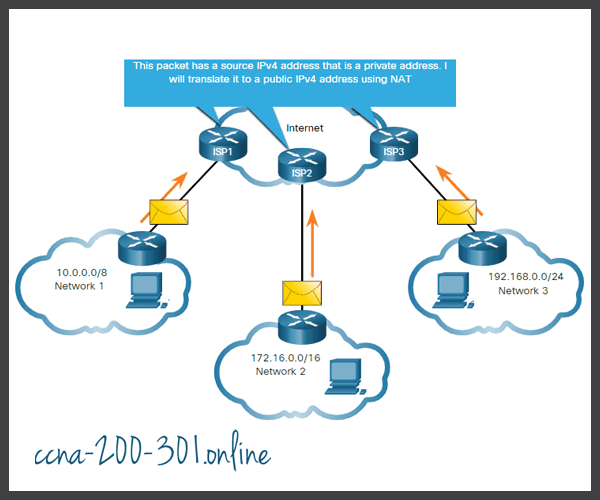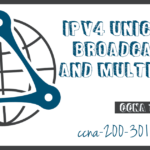Types of IPv4 Addresses
Summary
This topic explain public, private, and reserved IPv4 addresses. Start learning CCNA 200-301 for free right now!!
Table of Contents
Public and Private IPv4 Addresses
Just as there are different ways to transmit an IPv4 packet, there are also different types of IPv4 addresses. Some IPv4 addresses cannot be used to go out to the internet, and others are specifically allocated for routing to the internet. Some are used to verify a connection and others are self-assigned. As a network administrator, you will eventually become very familiar with the types of IPv4 addresses, but for now, you should at least know what they are and when to use them.
Public IPv4 addresses are addresses which are globally routed between internet service provider (ISP) routers. However, not all available IPv4 addresses can be used on the internet. There are blocks of addresses called private addresses that are used by most organizations to assign IPv4 addresses to internal hosts.
In the mid-1990s, with the introduction of the World Wide Web (WWW), private IPv4 addresses were introduced because of the depletion of IPv4 address space. Private IPv4 addresses are not unique and can be used internally within any network.
The Private Address Blocks
| Network Address and Prefix | RFC 1918 Private Address Range |
|---|---|
| 10.0.0.0/8 | 10.0.0.0 – 10.255.255.255 |
| 172.16.0.0/12 | 172.16.0.0 – 172.31.255.255 |
| 192.168.0.0/16 | 192.168.0.0 – 192.168.255.255 |
Organizations that have resources available to the internet, such as a web server, will also have devices that have public IPv4 addresses. As shown in the figure, this part of the network is known as the DMZ (demilitarized zone). The router in the figure not only performs routing, it also performs NAT and acts as a firewall for security.

[/alert-note]
Special Use IPv4 Addresses
There are certain addresses, such as the network address and broadcast address, that cannot be assigned to hosts. There are also special addresses that can be assigned to hosts, but with restrictions on how those hosts can interact within the network.
Loopback addresses
Loopback addresses (127.0.0.0 /8 or 127.0.0.1 to 127.255.255.254) are more commonly identified as only 127.0.0.1, these are special addresses used by a host to direct traffic to itself. For example, it can be used on a host to test if the TCP/IP configuration is operational, as shown in the figure. Notice how the 127.0.0.1 loopback address replies to the ping command. Also note how any address within this block will loop back to the local host, which is shown with the second ping in the figure.
Pinging the Loopback Interface
C:\Users\NetAcad> ping 127.0.0.1 Pinging 127.0.0.1 with 32 bytes of data: Reply from 127.0.0.1: bytes=32 time<1ms TTL=128 Reply from 127.0.0.1: bytes=32 time<1ms TTL=128 Reply from 127.0.0.1: bytes=32 time<1ms TTL=128 Reply from 127.0.0.1: bytes=32 time<1ms TTL=128 Ping statistics for 127.0.0.1: Packets: Sent = 4, Received = 4, Lost = 0 (0% loss), Approximate round trip times in milli-seconds: Minimum = 0ms, Maximum = 0ms, Average = 0ms C:\Users\NetAcad> ping 127.1.1.1 Pinging 127.1.1.1 with 32 bytes of data: Reply from 127.1.1.1: bytes=32 time<1ms TTL=128 Reply from 127.1.1.1: bytes=32 time<1ms TTL=128 Reply from 127.1.1.1: bytes=32 time<1ms TTL=128 Reply from 127.1.1.1: bytes=32 time<1ms TTL=128 Ping statistics for 127.1.1.1: Packets: Sent = 4, Received = 4, Lost = 0 (0% loss), Approximate round trip times in milli-seconds: Minimum = 0ms, Maximum = 0ms, Average = 0ms C:\Users\NetAcad>
Link-Local addresses
Link-local addresses (169.254.0.0 /16 or 169.254.0.1 to 169.254.255.254) are more commonly known as the Automatic Private IP Addressing (APIPA) addresses or self-assigned addresses. They are used by a Windows DHCP client to self-configure in the event that there are no DHCP servers available. Link-local addresses can be used in a peer-to-peer connection but are not commonly used for this purpose.
Legacy Classful Addressing
In 1981, IPv4 addresses were assigned using classful addressing as defined in RFC 790 (https://tools.ietf.org/html/rfc790), Assigned Numbers. Customers were allocated a network address based on one of three classes, A, B, or C. The RFC divided the unicast ranges into specific classes as follows:
- Class A (0.0.0.0/8 to 127.0.0.0/8) – Designed to support extremely large networks with more than 16 million host addresses. Class A used a fixed /8 prefix with the first octet to indicate the network address and the remaining three octets for host addresses (more than 16 million host addresses per network).
- Class B (128.0.0.0 /16 – 191.255.0.0 /16) – Designed to support the needs of moderate to large size networks with up to approximately 65,000 host addresses. Class B used a fixed /16 prefix with the two high-order octets to indicate the network address and the remaining two octets for host addresses (more than 65,000 host addresses per network).
- Class C (192.0.0.0 /24 – 223.255.255.0 /24) – Designed to support small networks with a maximum of 254 hosts. Class C used a fixed /24 prefix with the first three octets to indicate the network and the remaining octet for the host addresses (only 254 host addresses per network).
Note: There is also a Class D multicast block consisting of 224.0.0.0 to 239.0.0.0 and a Class E experimental address block consisting of 240.0.0.0 – 255.0.0.0.
At the time, with a limited number of computers using the internet, classful addressing was an effective means to allocate addresses. As shown in the figure, Class A and B networks have a very large number of host addresses and Class C has very few. Class A networks accounted for 50% of the IPv4 networks. This caused most of the available IPv4 addresses to go unused.
Summary of Classful Addressing

In the mid-1990s, with the introduction of the World Wide Web (WWW), classful addressing was deprecated to more efficiently allocate the limited IPv4 address space. Classful address allocation was replaced with classless addressing, which is used today. Classless addressing ignores the rules of classes (A, B, C). Public IPv4 network addresses (network addresses and subnet masks) are allocated based on the number of addresses that can be justified.
Assignment of IP Addresses
Public IPv4 addresses are addresses which are globally routed over the internet. Public IPv4 addresses must be unique.
Both IPv4 and IPv6 addresses are managed by the Internet Assigned Numbers Authority (IANA). The IANA manages and allocates blocks of IP addresses to the Regional Internet Registries (RIRs). The five RIRs are shown in the figure.
RIRs are responsible for allocating IP addresses to ISPs who provide IPv4 address blocks to organizations and smaller ISPs. Organizations can also get their addresses directly from an RIR (subject to the policies of that RIR).
Regional Internet Registries

- AfriNIC (African Network Information Centre) – Africa Region
- APNIC (Asia Pacific Network Information Centre) – Asia/Pacific Region
- ARIN (American Registry for Internet Numbers) – North America Region
- LACNIC (Regional Latin-American and Caribbean IP Address Registry) – Latin America and some Caribbean Islands
- RIPE NCC (Réseaux IP Européens Network Coordination Centre) – Europe, the Middle East, and Central Asia
Ready to go! Keep visiting our networking course blog, give Like to our fanpage; and you will find more tools and concepts that will make you a networking professional.






